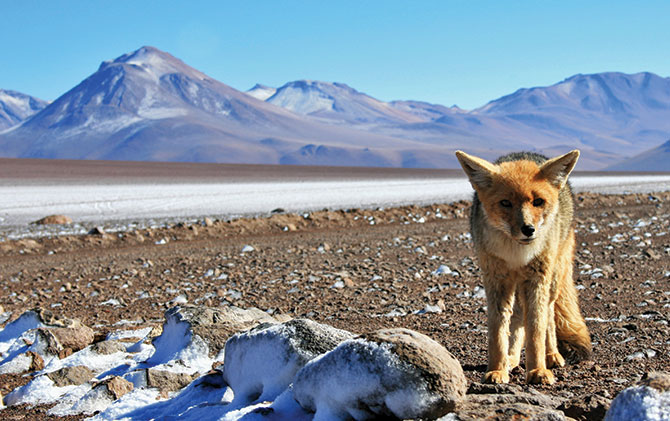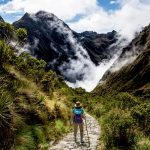Tucan Travel have launched a new Adventure Tour called ‘South America Flyer‘, In just 11 days, you will be able to admire colossal natural wonders and get to know Latin America’s most electrifying cities as you travel across the continent from Santiago to Rio de Janeiro. Encompassing South America’s principle gastronomic region, you’ll have plenty of opportunities to sample world class cuisine and taste some truly exceptional wines.
Day 1 – Santiago
Today, Santiago is a bustling cosmopolitan capital, but in the past it has been the backdrop for dark, dramatic events in the nation’s history. Just walk past the Chilean presidential palace, the ‘Palacio de la Moneda’ in the city centre, and you will discover bullet holes that can still be seen on certain lamp-posts and buildings around the Plaza de la Constitucion. In the 1970s, with the then-President Salvador Allende Gossens still inside, the palace was bombarded by the Chilean Air Force during the military coup d’état, ushering in a dark period in Chile’s national history in which the civilian government was abolished and Augusto Pinochet ruled a brutal dictatorship.

Nowadays, Santiago is a modern metropolis, and the best way to see it all is on a walking tour through the city centre. You will pass the Plaza de Armas, bordered on one side by the impressive Metropolitan Cathedral of Santiago, the Museo Nacional de Bellas Artes, an impressive fine art gallery housed in a colossal neo-classical building, and the city’s most renowned markets, such as the Mercado Central, one of the best seafood markets in the world. For the best views of the city, take a cable car or hike to the top of San Cristobal Hill, where the Statue of the Virgin overlooks the sprawling capital and the distant Andes that tower over the beautiful cityscape below. On San Cristobal, you can taste some of Chile’s best wines and seafood dishes in restaurants that offer exceptional views, especially at dusk.
Days 2-4 – Mendoza
Mendoza is the epicentre of Argentina’s wine country. Rebuilt on a grid system after a devastating earthquake flattened the city in 1861, the resulting tree-lined avenues and beautiful green plazas are reminiscent of certain European cities like Lyon, and make for a perfect aimless wander. Situated on the foothills of the Andes, the city is a great base to explore the surrounding countryside. For the adrenaline junky you can go white-water rafting, rappelling and horseback riding, the latter finishing with a steak BBQ and campfire that offers some great opportunities for star-gazing. But of course no trip to Mendoza would be complete without touring the surrounding vineyards. You can hire bikes and cycle the ‘Ruta de los Vinos’ (wine route), visiting both ancient bodegas and working commercial wineries, tasting some of the best Malbecs in the world.

Days 5-7
Buenos Aires, known as the ‘Paris of South America’ due to its lovely green parks, plazas and wide boulevards, is home to quirky local neighbourhoods where European and Latin American influences have mixed together to create a city like no other. Stroll down Avenida 9 de Julio, the widest avenue in the world, spotting the impressive Teatro Colón, an opera house that offers some of the best acoustics in the world. You can also visit the famous Casa Rosada, Argentina’s presidential palace, from where Juan and Eva Perón famously addressed the crowds gathered on Plaza de Mayo in 1945. Argentina’s capital city is a great destination for culture lovers, with the Museo Nacional de Bellas Artes boasting an impressive collection including original works by Monet, Renoir and Cézanne. You can also learn about the national heroin ‘Evita’ at the Museo Eva Perón.
Buenos Aires has a variety of craft markets, and if you stroll through them at the weekends you may come across live bands, barbecues, make-shift bars and practising tango dancers for a truly atmospheric Latin-American experience. San Telmo is the best market for antiques, while the market at Recoleta has great hand-made craft items. The nearby Recoleta Cemetery is also worth a visit – it has beautiful marble tombs and Eva Peron’s family tomb can be found here. No visit to Buenos Aires would be complete without a stroll around the upmarket boutiques and cafés of the Palermo district, and the contrasting bohemian barrio of La Boca, where poor inhabitants of the area used left-over paint from the nearby shipyards to paint their humble houses made of scrap metal in bright, block colours.

The city is also world-renowned for its incredible night-life, with many nightclubs, bars, restaurants and cinemas open all night. Go to any club at the weekend and you will see why ‘porteños’ (people from Buenos Aires) are known to party hard. You can see an authentic tango show in the city where the dance originated, and this usually includes a tango lesson and a traditional Argentinian dinner – and yes that means some of the best steak in the world!
Days 8-9 – Iguazú Falls
Iguazú Falls is one of the most magnificent natural wonders in the world. Unlike most other waterfalls that have just one or two cataracts, at Iguazú Falls there are 275 cataracts in a colossal 3km-long U-shape that can be visited from both the Brazilian and Argentinian sides. Visiting the Argentine side of the falls offers the opportunity to get up close to the many cataracts by walking on steel walkways that jut out of the rocks and take you through the surrounding rainforest. You can get so close to the falls that you’ll be covered in spray as the Iguazú River tumbles over the edge of the Paraná Plateau to become the Lower Iguazú River. Visiting the Brazilian side of the falls will give you a completely different perspective, as you come to understand the sheer size and power of the falls by walking on platforms that offer views of the whole panorama.

Days 10-11 – Rio de Janeiro
Incredible Rio de Janeiro needs no introduction. There are countless things to see and see in the ‘Marvellous City’ full of beautiful people. A highlight for many would be to experience the majestic gaze of Christ the Redeemer at the top of Corcovado, the breath-taking panoramic views from Sugarloaf Mountain, and the vibrant coloured tiles of the Selarón staircase. You can walk from the edgy Lapa district to the cobblestone hill-top neighbourhood of Santa Teresa, where you can take the old tram across the famous white viaduct into the historic centre of the city. Here, you can admire Rio’s old colonial mansions and government buildings built when the city was the former capital of Brazil. Alternatively, you may like to visit the Botanical Gardens, or the beautiful Rodrigues de Freitas Lagoon. You can’t leave Rio de Janeiro without dining out at one of its famous ‘churrascarias’, where different cuts of meat are seasoned and barbecued to perfection, or at one of its ‘rodizio’ buffets where you pay by the kilo! End the experience of a lifetime by watching the sun set behind the Two Brothers mountain from Ipanema Beach, making a toast to your next adventure with a well-deserved ‘Caipirinha’ in hand.

About the Author: Marcus Hunt is Marketing Assistant for Tucan Travel. He has travelled independently throughout Europe and North, Central and South America, and has studied or worked in France, Italy and Brazil. You can find him on Google+ or read his other contributions here.
Spread the love



